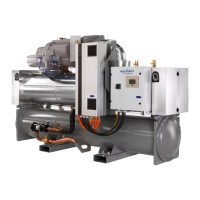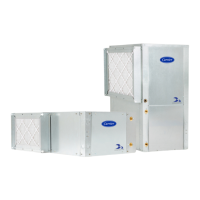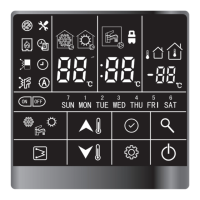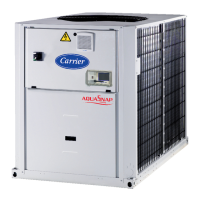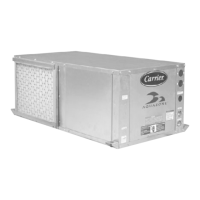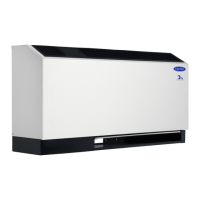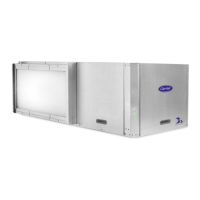21
7 - WATER CONNECTIONS
ATTENTION: Before carrying out any water connections
install the water box purge plugs (one plug per water box in
the lower section supplied in the control box).
For size and position of the heat exchanger water inlet and outlet
connections refer to the certied dimensional drawings supplied
with the unit.
The water pipes must not transmit any radial or axial force to the
heat exchangers nor any vibration.
The water supply must be analysed and appropriate ltering,
treatment, control devices, isolation and bleed valves and circuits
built in, to prevent corrosion, fouling and deterioration of the pump
ttings. Consult either a water treatment specialist or appropriate
literature on the subject.
7.1 - Operating precautions
The water circuit should be designed to have the least number of
elbows and horizontal pipe runs at different levels. Below the main
points to be checked for the connection:
• Comply with the water inlet and outlet connections shown
on the unit.
• Install manual or automatic air purge valves at all high points
in the circuit(s).
• Use a pressure reducer to maintain pressure in the circuit(s)
and install a safety valve as well as an expansion tank.
• Install thermometers in both the entering and leaving water
connections.
• Install drain connections at all low points to allow the whole
circuit to be drained.
• Install stop valves, close to the entering and leaving water
connections.
• Use flexible connections to reduce the transmission
of vibrations.
• Insulate all pipework, after testing for leaks, both to reduce
heat gains and to prevent condensation.
• Cover the insulation with a vapour barrier.
Where there are particles in the uid that could foul the heat
exchanger, a screen lter should be installed ahead of the pump.
The mesh size of the lter must be 1.2 mm.
Before the system start-up verify that the water circuits are
connected to the appropriate heat exchangers (e.g. no reversal
between evaporator and condenser). Do not introduce any
signicant static or dynamic pressure into the heat exchange circuit
(with regard to the design operating pressures). Before any start-
up verify that the heat exchange uid is compatible with the
materials and the water circuit coating. The use of different metals
on hydraulic piping could generate eletrolytic pairs and
consequently corrosion. It could be needed to add sacricial
anodes. In case additives or other uids than those recommended
by Carrier are used, ensure that the uids are not considered as
a gas, and that they belong to class 2, as dened in directive 97/23/
EC.
Carrier recommendations on heat exchange uids:
• No NH
4
+
ammonium ions in the water, they are very
detrimental for copper. This is one of the most important
factors for the operating life of copper piping. A content of
several tenths of mg/l will badly corrode the copper over
time.
• Cl
-
Chloride ions are detrimental for copper with a risk of
perforations by corrosion by puncture. If possible keep
below 125 mg/l.
• SO
4
2-
sulphate ions can cause perforating corrosion, if their
content is above 30 mg/l.
• No uoride ions (<0.1 mg/l).
• No Fe
2+
and Fe
3+
ions with non negligible levels of dissolved
oxygen must be present. Dissolved iron < 5 mg/l with
dissolved oxygen < 5 mg/l.
• Dissolved silicon: silicon is an acid element of water and
can also lead to corrosion risks. Content < 1 mg/l.
• Water hardness: > 0.5 mmol/l. Values between 1 and 2.5 can
be recommended. This will facilitate scale deposit that can
limit corrosion of copper. Values that are too high can cause
piping blockage over time. A total alkalimetric titre (TAC)
below 100 mg/l is desirable.
• Dissolved oxygen: Any sudden change in water oxygenation
conditions must be avoided. It is as detrimental to deoxygenate
the water by mixing it with inert gas as it is to over-oxygenate it
by mixing it with pure oxygen. The disturbance of the oxygenation
conditions encourages destabilisation of copper hydroxides and
enlargement of particles
.
• Electric conductivity 10-600µS/cm.
• pH: Ideal case pH neutral at 20-25°C 7 < pH < 8
When the water circuit must be emptied for longer than one month
or immediately if the water does not comply with the above
description, the circuit must be either totally dried or placed under
0.5 bar maximum nitrogen charge. This is done to avoid any
damage of the exchanger copper tubes with corrosion by
differential aeration. In case of nitrogen charge, the circuit must
be equipped with relief valves to avoid overpressure due to
refrigerant leakage. Charging and removing heat exchange uids
should be done with devices that must be included on the water
circuit by the installer. Never use the unit heat exchangers to add
heat exchange uid.
CAUTION: Filling, completing and draining the water circuit
charge must be done by qualied personnel, using the air
purges and materials that are suitable for the products.
Charging and removing heat exchange uids should be done
with devices that must be included on the water circuit by the
installer. Never use the unit heat exchangers to add heat
exchange uid.
7.2 - Water connections
The water connections are Victaulic type connections. The inlet
and outlet connection diameters are identical.
Inlet/outlet diameters
61XWH
Model 3 5 7 10 14 15 17
Evaporator
Standard unit
Nominal diameter in 5 6 8 8 8 8 8
Actual outside diameter mm 141,3 168,3 219,1 219,1 219,1 219,1 219,1
Unit with option 100A
Nominal diameter in 4 5 6 6 6 6 6
Actual outside diameter mm 114,3 141,3 168,3 168,3 168,3 168,3 168,3
Unit with option 100C
Nominal diameter in 5 6 8 8 8 8 8
Actual outside diameter mm 141,3 168,3 219,1 219,1 219,1 219,1 219,1
Condenser
Standard unit
Nominal diameter in 5 6 8 8 8 8 8
Actual outside diameter mm 141,3 168,3 219,1 219,1 219,1 219,1 219,1
Unit with option 102A
Nominal diameter in 4 5 6 6 6 8 8
Actual outside diameter mm 114,3 141,3 168,3 168,3 168,3 219,1 219,1
Unit with option 102C
Nominal diameter in 6 8 8 8 8 8 8
Actual outside diameter mm 168,3 219,1 219,1 219,1 219,1 219,1 219,1
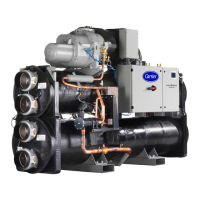
